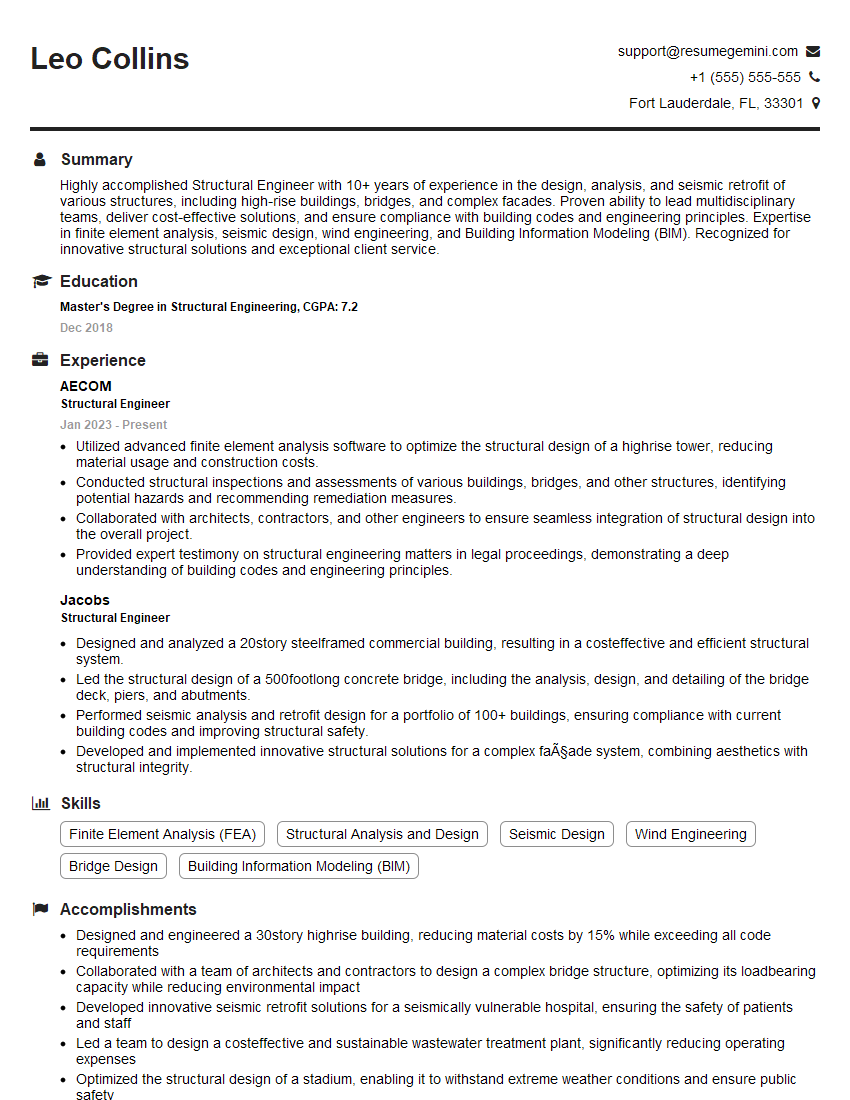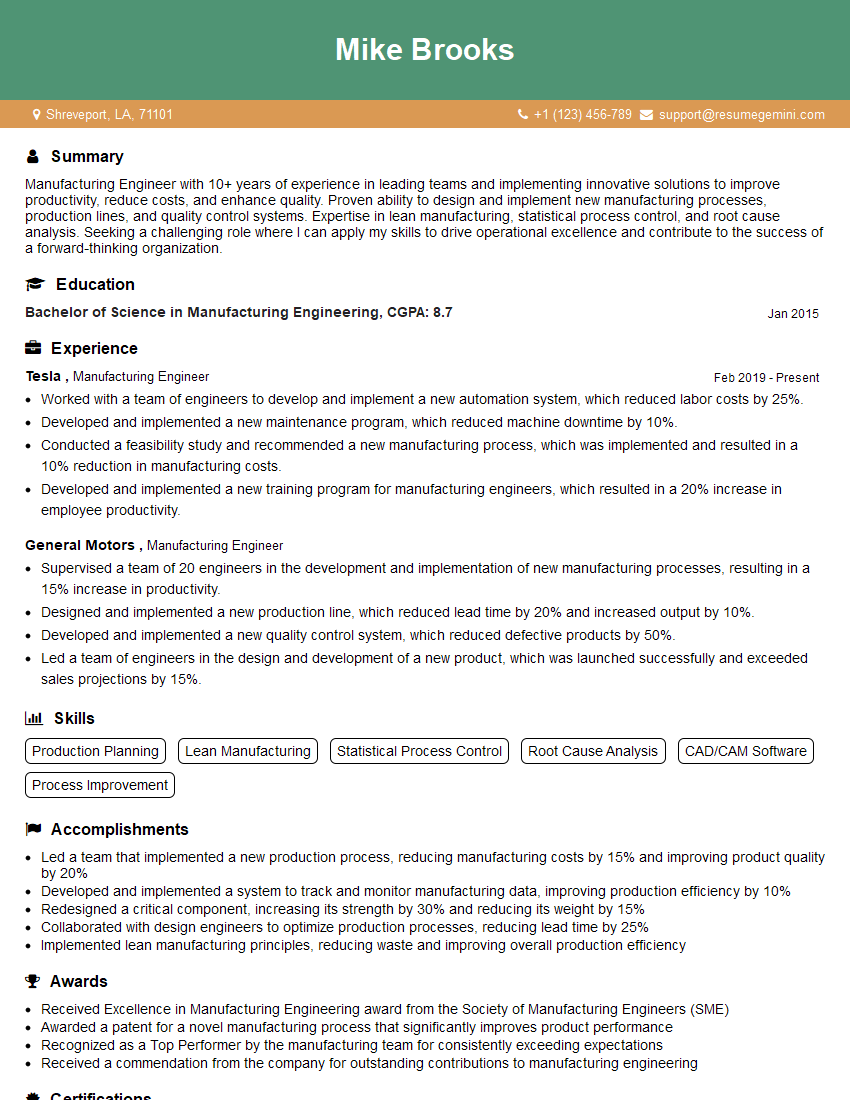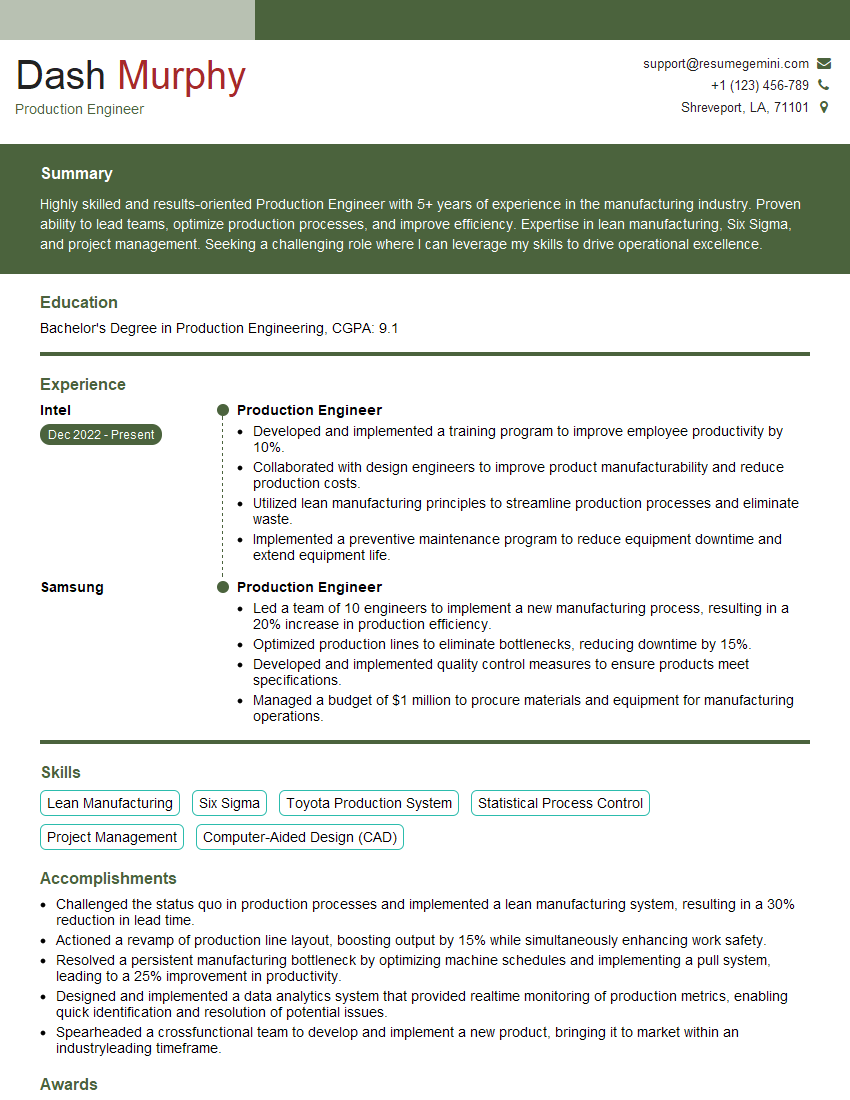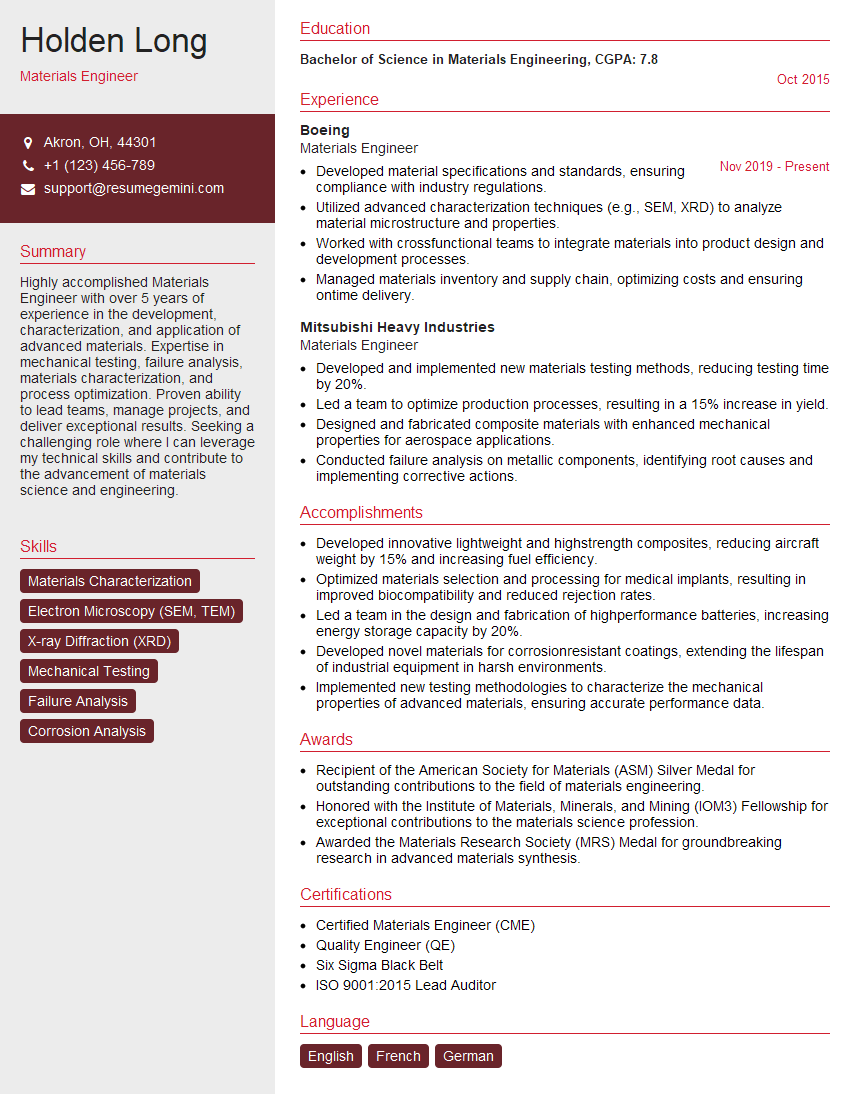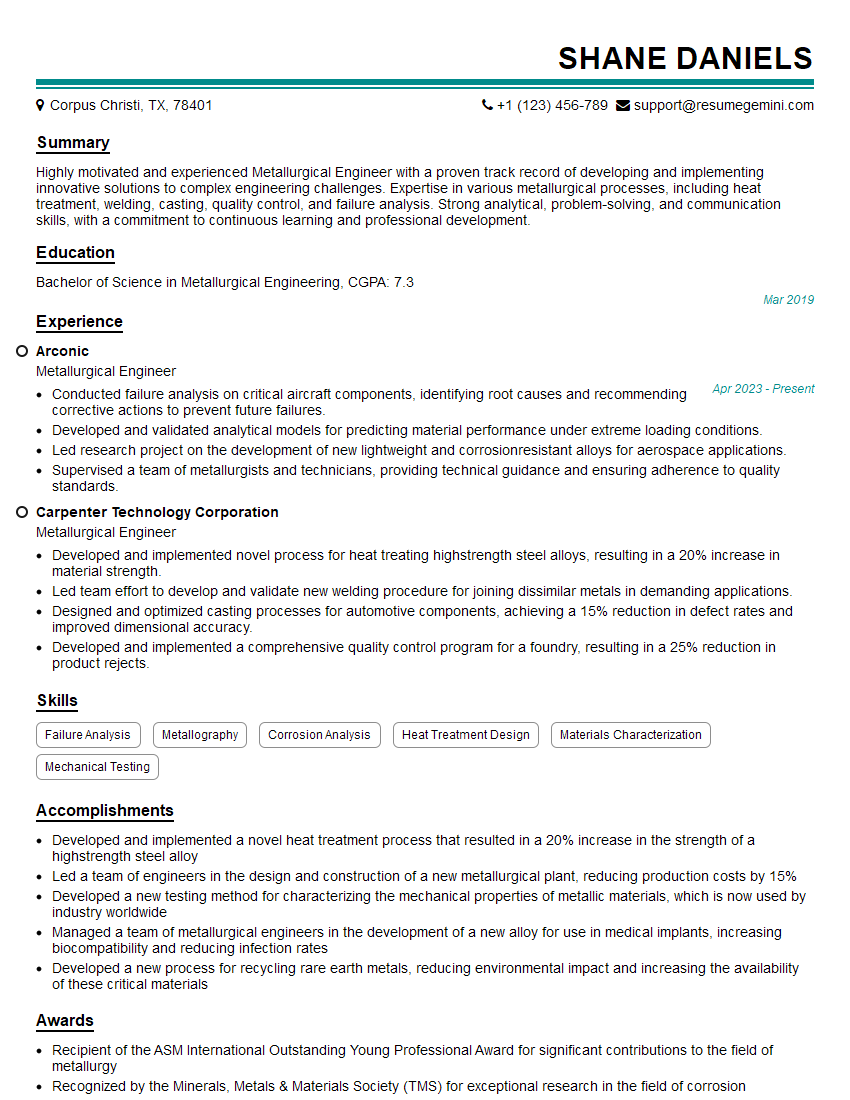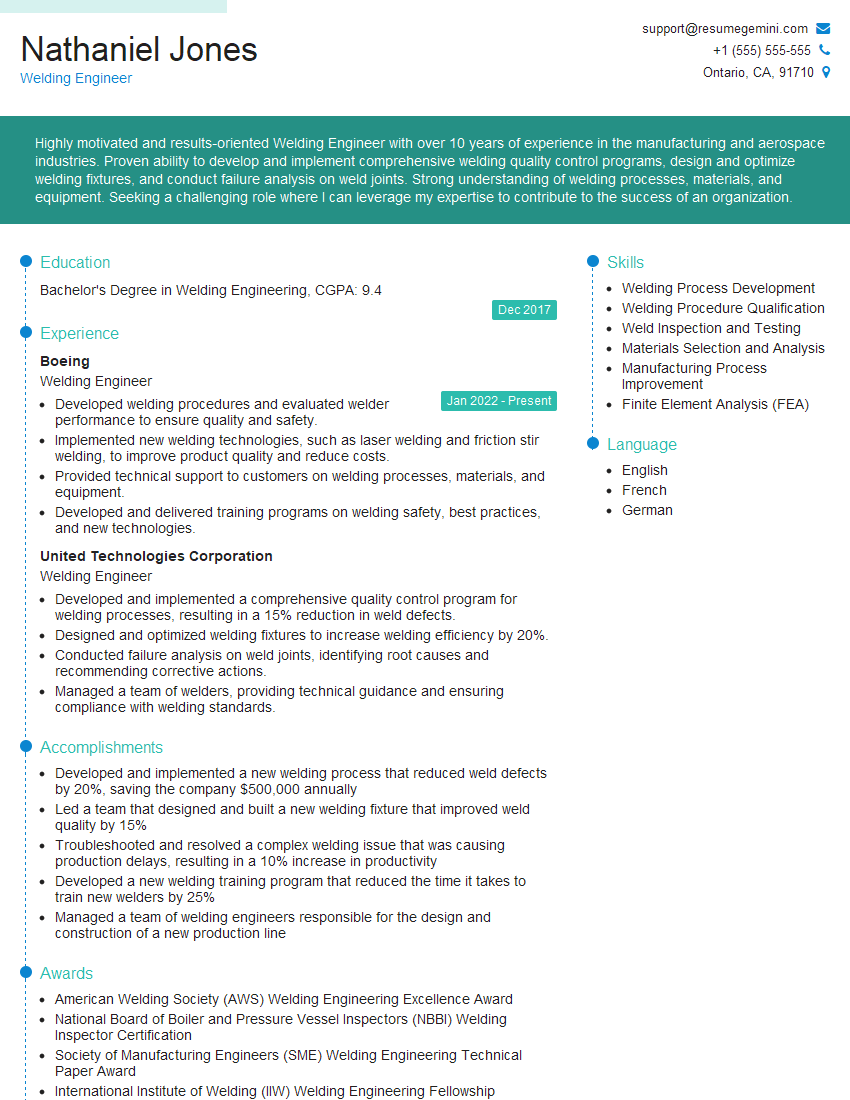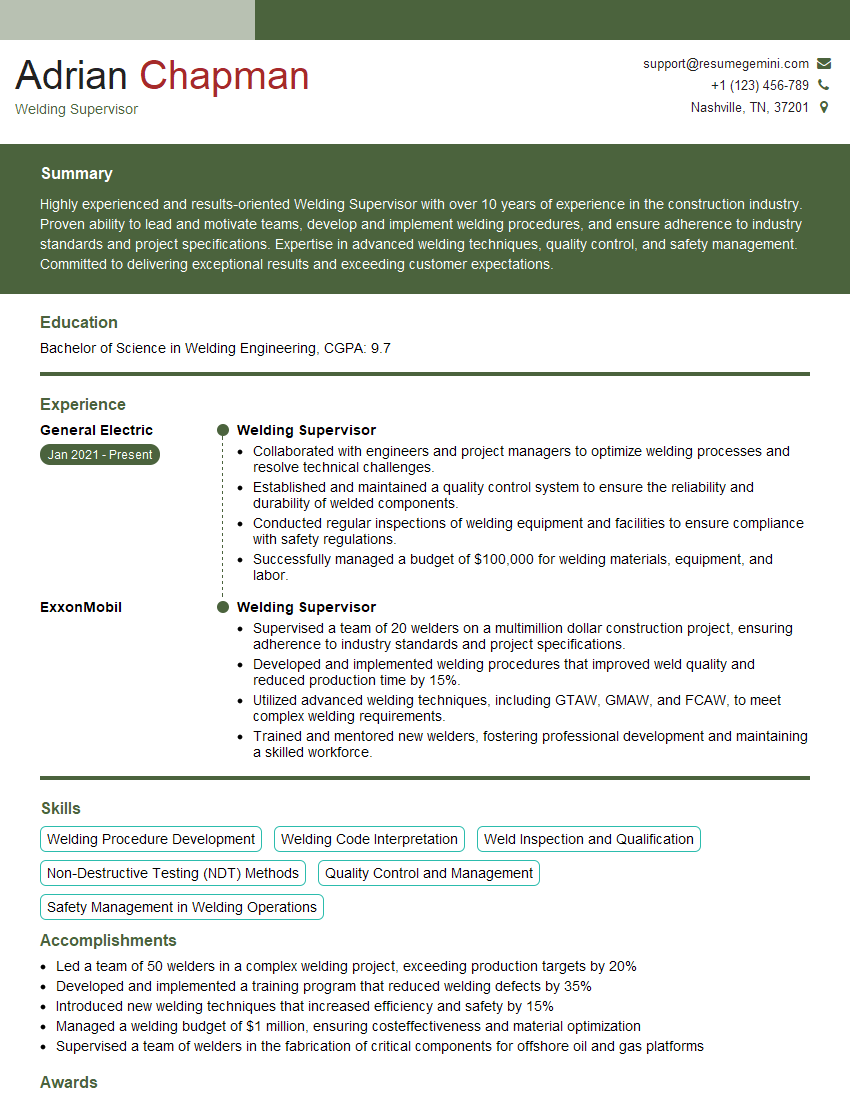Every successful interview starts with knowing what to expect. In this blog, we’ll take you through the top Design for Weldability interview questions, breaking them down with expert tips to help you deliver impactful answers. Step into your next interview fully prepared and ready to succeed.
Questions Asked in Design for Weldability Interview
Q 1. Explain the principles of Design for Weldability (DFW).
Design for Weldability (DFW) is a crucial engineering approach that prioritizes ease of welding during the design phase of a product. It aims to minimize welding difficulties, reduce costs, enhance weld quality, and improve the overall product performance. The core principles involve selecting appropriate materials, designing weld-friendly geometries, and considering the welding process from the outset. Think of it like baking a cake – if you don’t have the right ingredients and the correct recipe, you won’t get a good result. Similarly, poor DFW leads to weld defects and potentially catastrophic failures.
DFW incorporates several strategies: proper material selection considering weldability, simplification of geometry to avoid complex welds, incorporation of access for welders, and design for weld cooling to minimize distortion and cracking.
Q 2. What are the key considerations for designing weldable parts?
Designing weldable parts requires careful consideration of several key factors:
- Material Selection: Choose materials with good weldability, considering factors like melting point, thermal conductivity, and susceptibility to cracking. For instance, low-carbon steel is generally preferred for its easy weldability compared to high-alloy steels which may require specialized welding techniques.
- Joint Design: The type of weld joint significantly influences weldability. Simple joints like butt welds are generally easier to weld than complex joints like T-joints or corner welds. We’ll discuss joint design in more detail later.
- Geometry and Accessibility: Design parts with sufficient access for the welding process. Avoid confined spaces or complex geometries that hinder welder access. Think of a welder needing to reach all sections of the weld – good design ensures this is possible.
- Weldment Thickness and Dimensions: Excessive thickness can lead to weld defects, such as incomplete penetration or porosity. Careful consideration of these factors is crucial to ensuring a consistent and quality weld.
- Heat Affected Zone (HAZ): Consider the potential for the HAZ, the area of the base material affected by the welding heat, to alter the mechanical properties of the part. This is especially important for high-strength materials.
- Residual Stresses: Welding introduces residual stresses, which can lead to cracking or distortion. DFW aims to minimize these stresses through proper design and post-weld treatments.
Q 3. Describe different types of welding processes and their suitability for various materials.
Various welding processes exist, each suited to specific materials and applications:
- Gas Metal Arc Welding (GMAW): Versatile, widely used for steels, aluminum, and stainless steel. It’s efficient for thicker materials. Think of it as a continuous wire feeding into the weld pool, offering good control and speed.
- Gas Tungsten Arc Welding (GTAW): Provides high-quality welds with excellent control, particularly suitable for thinner materials and critical applications. It’s prized for its precision but is slower than GMAW.
- Shielded Metal Arc Welding (SMAW): A common process using stick electrodes, ideal for field applications due to its portability. It’s cost-effective but produces welds with slightly lower quality than GMAW or GTAW.
- Resistance Welding: Uses electrical resistance heat to forge a weld. Very fast for joining similar metals, ideal for mass production but often limited to thinner materials. Think spot welding in car manufacturing.
Material compatibility is paramount; for instance, GMAW is widely used for steel, while GTAW excels with aluminum due to its higher control over the weld pool and ability to prevent oxidation.
Q 4. How do you select the appropriate welding consumables for a specific application?
Selecting the right welding consumables is critical for achieving high-quality welds. The choice depends on several factors:
- Base Material: The type of metal being welded dictates the type of filler metal (electrode or wire) needed for compatibility. For instance, welding stainless steel requires a filler metal of similar composition to maintain corrosion resistance.
- Welding Process: Different processes require different consumables. GMAW uses solid or flux-cored wire, while SMAW uses coated electrodes (sticks).
- Weld Joint Design: The joint configuration impacts the selection of filler metal size and type, as well as the shielding gas (if applicable).
- Mechanical Properties: The required mechanical properties of the weld dictate the filler metal’s composition and strength.
Selecting the incorrect consumables can lead to poor weld quality, cracking, and ultimately, part failure. A well-defined welding procedure specification (WPS) guides this selection process, ensuring consistent and reliable results.
Q 5. Explain the importance of joint design in weldability.
Joint design is paramount for weldability. A well-designed joint simplifies the welding process, minimizes weld defects, and improves the strength of the weld. Poor joint design can lead to difficulties in achieving proper fusion, increased residual stresses, and even failure.
Optimal joint designs often include:
- Butt Joints: Simple, strong, but require precise alignment.
- Lap Joints: Easier to weld but can be weaker than butt joints.
- T-Joints: Can be challenging to weld properly, requiring careful attention to penetration and avoiding undercut.
- Corner Joints: Similar challenges to T-joints, demanding skilled welding techniques.
The choice of joint design is a balance between weldability, strength, and cost. Simple joints are usually preferred for ease of welding and lower costs, but complex geometries might necessitate more complex joint designs.
Q 6. What are the common weld defects and their causes?
Several common weld defects can occur, each with its own causes:
- Porosity: Small holes in the weld metal, often caused by gases trapped during welding (e.g., moisture in the electrode or shielding gas). Imagine bubbles in a cake – not a good sign!
- Incomplete Penetration: The weld metal doesn’t fully fuse with the base material. This can result from insufficient heat input or improper joint fit-up.
- Undercut: A groove melted into the base metal adjacent to the weld. Typically caused by excessive current, improper welding technique, or insufficient shielding.
- Cracking: Fractures in the weld metal or the HAZ, often due to high residual stresses, improper heat input, or material incompatibility.
- Slag Inclusion: Trapped slag (the byproduct of welding) within the weld. This reduces weld strength and can cause premature failure.
Careful attention to welding parameters, proper joint preparation, and skilled welding techniques are critical to preventing these defects.
Q 7. How do you prevent weld cracking?
Preventing weld cracking is crucial for ensuring the structural integrity of a weldment. Strategies to minimize weld cracking include:
- Preheating: Warming the base material before welding reduces the cooling rate and minimizes residual stresses. Think of it as gradually slowing down the cooling process to prevent sudden stress build-up.
- Interpass Temperature Control: Maintaining appropriate temperatures between weld passes helps control cooling rates and prevents cracking. This is particularly important for thicker sections.
- Post-Weld Heat Treatment (PWHT): A heat treatment process applied after welding to relieve residual stresses and improve toughness. It’s often used for critical applications.
- Proper Welding Technique: Using the correct welding parameters (current, voltage, travel speed) and maintaining proper weld pool control helps minimize residual stresses and cracking.
- Material Selection: Choosing materials with good weldability and low susceptibility to cracking is paramount.
- Joint Design: As discussed earlier, simple joint designs with adequate access promote better weldability and reduce cracking.
A comprehensive approach combining these strategies is usually necessary to effectively prevent weld cracking.
Q 8. Describe your experience with different types of weld joint preparation.
Weld joint preparation is crucial for achieving strong, reliable welds. It involves shaping the edges of the materials to be joined to ensure proper fusion and penetration. The type of preparation depends heavily on the material thickness, the welding process, and the desired weld geometry. Common types include:
- Butt Joint: Edges are prepared to be flush, often with a bevel or a ‘V’ shape to allow for complete penetration. A simple square butt joint is suitable for thin materials, while thicker materials require more elaborate preparations like single-V, double-V, or U-groove preparations to ensure complete weld penetration.
- Lap Joint: One piece overlaps the other. Simple and easy to prepare, but generally weaker than butt joints, making it more suitable for low stress applications.
- T-Joint: One piece is perpendicular to another. Preparation often involves beveling the vertical member to ensure good penetration and fusion with the horizontal member.
- Corner Joint: Two pieces meet at a corner. Similar to T-joints, the preparation depends on the thickness of the materials and the type of weld being applied.
- Edge Joint: Edges are prepared to be butted against each other but may not require bevelling, depending on the thickness.
The choice of joint preparation significantly impacts weld quality, mechanical properties, and overall cost-effectiveness. For instance, a double-V preparation, while providing excellent penetration and strength, requires more time and material removal than a simple square butt weld.
Q 9. What are the factors affecting weld strength and durability?
Weld strength and durability are influenced by a multitude of factors. Think of it like baking a cake – if you don’t have the right ingredients and baking process, your cake won’t turn out well. Similarly, several parameters affect weld quality:
- Base Material Properties: The chemical composition and microstructure of the base materials directly impact weldability and the strength of the resulting weld. Some materials are inherently more weldable than others.
- Weld Procedure: The welding process itself (e.g., Gas Metal Arc Welding (GMAW), Shielded Metal Arc Welding (SMAW), Tungsten Inert Gas Welding (TIG)) significantly impacts the weld’s microstructure and strength. The parameters like current, voltage, and travel speed also play a critical role.
- Weld Joint Design: As discussed earlier, proper joint preparation minimizes stress concentrations and facilitates complete penetration. Poor joint design leads to stress concentration, weakening the weld.
- Heat Input: Excessive heat input can cause excessive grain growth and weakening of the HAZ (Heat Affected Zone), while insufficient heat input results in incomplete fusion and porosity.
- Pre and Post-Weld Heat Treatments: These treatments can alleviate residual stresses and improve the overall mechanical properties of the weldment.
- Weld Defects: Porosity, cracks, slag inclusions, and lack of fusion dramatically reduce weld strength and durability. Regular inspections are crucial.
Addressing each of these factors diligently ensures optimal weld strength and a longer lifespan of the welded structure. For example, a poorly designed butt joint in a high-stress application like a bridge is unacceptable, as it could lead to catastrophic failure.
Q 10. How do you perform a weldability test?
Weldability testing involves assessing a material’s suitability for welding and determining the optimal welding parameters. Different tests exist, depending on the required information. These can include:
- Mechanical Testing: Tensile tests, bend tests, and impact tests are performed on weld samples to determine strength, ductility, and toughness. This allows us to evaluate the quality of the weld compared to the base material.
- Macro and Micro Examination: Visual inspection, macro etching, and microscopic analysis reveal defects like cracks, porosity, and inclusions in the weld metal and HAZ. This gives a detailed picture of the internal weld structure.
- Hardness Testing: Measures the hardness of the weld metal and HAZ, providing insights into the effect of heat input on the microstructure. Knowing the hardness profile helps assess the risk of cracking.
- Charpy Impact Test: Evaluates the material’s ability to absorb impact energy, crucial for assessing the weld’s fracture toughness, particularly in low-temperature environments.
- Guided Bend Test: This test is particularly useful for assessing the ductility and the weld’s ability to withstand bending loads.
The choice of specific tests depends on the application and the required weld quality. For a high-pressure pipeline, for example, a thorough series of tests, including Charpy impact and radiography, is crucial to ensure safety and reliability.
Q 11. Explain the concept of Heat Affected Zone (HAZ) and its impact on material properties.
The Heat Affected Zone (HAZ) is the area of the base material adjacent to the weld that is not melted but has undergone metallurgical changes due to the heat input from the welding process. Imagine heating a piece of metal – the area directly exposed to the heat changes significantly, but the surrounding area is also affected, albeit less drastically. The HAZ’s properties often differ from those of the base metal.
The changes in the HAZ can significantly impact material properties:
- Hardness: The HAZ can be significantly harder than the base metal, leading to increased brittleness and a higher susceptibility to cracking. This is especially problematic for high-strength steels.
- Ductility: The HAZ often exhibits reduced ductility compared to the base material.
- Toughness: A reduction in toughness can make the HAZ vulnerable to brittle fracture, especially at low temperatures.
- Microstructure: The HAZ microstructure can vary depending on the base metal, welding process, and heat input. Understanding this microstructure change is key to predicting the HAZ properties.
Proper pre and post-weld heat treatments and material selection are crucial to manage the HAZ and prevent problems like cracking or embrittlement. For example, preheating the base metal can reduce the temperature gradient and mitigate HAZ problems in susceptible materials.
Q 12. How do residual stresses affect weldments?
Residual stresses are internal stresses within a welded structure that remain after the welding process is completed. These stresses are a consequence of the non-uniform heating and cooling during welding. Think of it like a metal trying to ‘remember’ its original shape after being heated and bent. These stresses can significantly affect weldments:
- Distortion: Residual stresses can cause the welded component to warp or deform, potentially affecting its functionality and dimensional accuracy.
- Stress Corrosion Cracking (SCC): In corrosive environments, residual stresses can accelerate SCC, leading to premature failure.
- Fatigue: Residual stresses can reduce the fatigue life of the welded structure, making it more susceptible to failure under cyclic loading.
- Brittle Fracture: High residual stresses can trigger brittle fracture, especially in the HAZ, even at low stresses.
Strategies for managing residual stresses include preheating, post-weld heat treatment (stress relieving), and proper weld sequence control. In critical applications, stress analysis is performed to ensure that residual stresses are within acceptable limits.
Q 13. What are the different types of weld symbols and their meanings?
Weld symbols are a standardized graphical representation of weld requirements, providing concise information about the type of weld, its dimensions, and other essential details. They are critical for clear communication between designers, welders, and inspectors. A weld symbol typically consists of several components:
- Reference Line: A horizontal line that serves as a base for the symbol.
- Arrow Side: Indicates the side of the joint where the weld is applied.
- Other Side: Indicates the opposite side of the joint. Different symbols are used to denote whether the weld is the same on both sides or different.
- Basic Weld Symbol: Represents the type of weld (e.g., fillet weld, groove weld).
- Dimensional Data: Includes details like weld leg size, weld throat thickness, and penetration depth.
- Supplementary Symbols: Indicate additional requirements such as weld finish, backing, and other specific characteristics.
For example, a symbol might show a groove weld with a specific size and angle, indicating to the welder the type of preparation and weld required. Understanding weld symbols is critical for ensuring consistent weld quality and preventing errors in fabrication.
Q 14. Explain the importance of proper material selection for weldability.
Proper material selection for weldability is paramount for ensuring a strong, durable, and reliable weld. The choice of material must consider several factors:
- Weldability Index: Some materials are inherently more weldable than others. This weldability index provides guidance on the suitability for welding different types of materials.
- Chemical Composition: The chemical composition affects the material’s melting point, susceptibility to cracking, and other relevant welding characteristics. Certain elements can make welding more challenging.
- Microstructure: The microstructure impacts the material’s response to heat, and hence, its weldability. Coarse-grained materials are often more difficult to weld than fine-grained materials.
- Thickness: Thicker materials require more sophisticated joint preparations and welding techniques to achieve complete penetration.
- Application Requirements: The intended use of the welded component determines the required mechanical properties of the weld metal and the base material. High-strength steel may be used for applications with high load bearing requirements, while a lower-strength material may suffice in lower stress scenarios.
For instance, selecting a material with a high carbon content for a critical weld can lead to increased brittleness and potential cracking. Careful consideration of the material’s properties, the welding process, and the intended use ensures the success of a welding project.
Q 15. How do you ensure the quality of welded joints?
Ensuring the quality of welded joints is paramount for structural integrity and safety. It’s a multi-faceted process that begins long before the welding torch is ignited. We need to consider the entire process, from material selection and preparation to post-weld inspection.
- Material Selection: Choosing the right base materials with appropriate chemical composition and mechanical properties is crucial. Inconsistencies in material can lead to weld defects.
- Joint Design: Proper joint design minimizes stress concentrations and ensures good penetration. For example, a properly designed butt joint will distribute stress more effectively than a poorly designed lap joint.
- Welding Procedure Qualification (WPQ): A WPQ ensures the chosen welding parameters (current, voltage, travel speed, etc.) produce consistently sound welds. This is often tested through destructive and non-destructive testing of sample welds.
- Pre-Weld Cleaning: Removing contaminants like oil, grease, and paint is essential for good weld fusion. Failure to do so can result in porosity or other defects.
- Non-Destructive Testing (NDT): Methods like radiographic testing (RT), ultrasonic testing (UT), and visual inspection (VT) are crucial for detecting internal and external flaws in the weld after completion.
- Post-Weld Heat Treatment (PWHT): In some cases, PWHT is necessary to relieve residual stresses and improve the weld’s toughness and ductility. This is particularly important for high-strength steels.
Imagine building a bridge – every weld is critical. A single flawed weld could have catastrophic consequences. That’s why a rigorous quality control program, encompassing all these steps, is essential.
Career Expert Tips:
- Ace those interviews! Prepare effectively by reviewing the Top 50 Most Common Interview Questions on ResumeGemini.
- Navigate your job search with confidence! Explore a wide range of Career Tips on ResumeGemini. Learn about common challenges and recommendations to overcome them.
- Craft the perfect resume! Master the Art of Resume Writing with ResumeGemini’s guide. Showcase your unique qualifications and achievements effectively.
- Don’t miss out on holiday savings! Build your dream resume with ResumeGemini’s ATS optimized templates.
Q 16. What are your experiences with different welding codes and standards (e.g., AWS, ASME)?
My experience spans various welding codes and standards, primarily AWS (American Welding Society) and ASME (American Society of Mechanical Engineers) codes. I’ve worked extensively with codes like AWS D1.1 (Structural Welding Code – Steel) and ASME Section IX (Welding and Brazing Qualifications). I understand the nuances of each code, including specific requirements for prequalification, procedure qualification records (PQRs), welder performance qualification records (WQRs), and the selection of appropriate welding processes for different applications.
For instance, AWS D1.1 guides the design and welding of steel structures, specifying requirements for weld types, sizes, and inspection procedures. ASME Section IX, on the other hand, focuses on the qualification of welding procedures and welders, providing a framework for ensuring consistent weld quality across various industries, including power generation and pressure vessels. The differences between these codes lie primarily in the application and the level of detail required for qualification. I am comfortable navigating the complexities of both and can choose the appropriate standard based on the project specifications.
Q 17. Describe your experience with Finite Element Analysis (FEA) in weld design.
Finite Element Analysis (FEA) is an indispensable tool in weld design. It allows us to predict stress distributions, deformation, and potential failure points in welded structures under various loading conditions. I’ve used FEA extensively to optimize weld designs, reducing distortion and improving overall structural performance.
For example, in designing a complex pressure vessel, we can use FEA to model the weld and surrounding base material. By applying load simulations, we can identify areas of high stress concentration around the weld. This information allows us to adjust the weld design, perhaps by changing the weld type or adding reinforcement, to mitigate stress and prevent potential failures. Software like ANSYS and Abaqus are my go-to tools for conducting these analyses. FEA isn’t just about detecting problems; it helps in proactively designing robust and reliable weldments.
Q 18. How do you address design challenges related to weld distortion?
Weld distortion is a common challenge in welding, often leading to dimensional inaccuracies and residual stresses. Addressing this requires a multi-pronged approach:
- Joint Design: Strategic joint design can minimize distortion. For example, using a balanced joint design, where the weld metal addition is symmetrical, can reduce distortion significantly compared to an unbalanced design.
- Welding Sequence: The order in which welds are applied significantly impacts distortion. Careful planning of the welding sequence, often involving pre-heating or using a specific tack welding pattern, can help control distortion.
- Fixturing: Proper fixturing of the components before welding restricts movement and minimizes distortion. This can involve using clamps, jigs, or other restraining devices.
- Preheating/Post-weld Heat Treatment: Preheating the base material before welding can reduce thermal gradients and minimize distortion. Similarly, PWHT can help relieve residual stresses caused by the welding process.
- Controlled Cooling: Slow cooling after welding can minimize distortion. This can be achieved through insulation or controlled environments.
Imagine welding two large steel plates together. Without proper precautions, the heat input from the welding process can cause significant warping. By carefully controlling the welding sequence, fixturing, and employing preheating or post-weld heat treatment, we can significantly reduce, or even eliminate, this warping.
Q 19. What software and tools are you proficient in for weld design and analysis?
My proficiency in software and tools for weld design and analysis is extensive. I’m highly skilled in using FEA software such as ANSYS and Abaqus for stress analysis and simulation. I’m also proficient in CAD software like SolidWorks and AutoCAD, allowing me to create detailed weld joint designs and integrate them into larger assemblies. Furthermore, I’m familiar with specialized welding simulation software that allows detailed prediction of weld pool behavior and distortion.
Beyond software, I’m adept at using various measurement tools, including calipers, micrometers, and specialized NDT equipment such as ultrasonic flaw detectors and radiographic inspection systems. This combination of software and hands-on experience enables me to approach weld design holistically and effectively.
Q 20. Explain your approach to troubleshooting welding problems on the production line.
Troubleshooting welding problems on the production line requires a systematic approach. I follow a structured process:
- Gather Data: This involves collecting information about the problem, including visual observations of the weld defects (e.g., porosity, cracking, lack of fusion), welding parameters used, and any variations in the welding process.
- Analyze Data: Analyzing the gathered data often reveals clues about the root cause. For example, excessive porosity could indicate improper shielding gas coverage or contaminated base material.
- Develop Hypotheses: Based on the analysis, we formulate potential causes of the problem. These might include incorrect welding parameters, inappropriate filler material, poor joint preparation, or problems with the welding equipment.
- Test Hypotheses: We conduct targeted tests to verify our hypotheses. This might involve re-welding test samples with adjusted parameters or inspecting the welding equipment for malfunctions.
- Implement Corrective Actions: Once the root cause is identified and verified, we implement appropriate corrective actions. This could include adjusting welding parameters, replacing faulty equipment, or refining the welding procedure.
- Monitor Results: After implementing corrective actions, we closely monitor the welding process to ensure the problem is resolved and does not recur.
For instance, if I observe numerous cracks in a weld, I might hypothesize about the presence of hydrogen embrittlement. I would then test this hypothesis by examining the welding process for potential sources of hydrogen, such as moisture in the filler material or inadequate preheating.
Q 21. How do you ensure the safety of welders and the welding process?
Ensuring welder safety and the safety of the welding process is paramount. This involves a comprehensive approach encompassing several key elements:
- Personal Protective Equipment (PPE): Welders must always use appropriate PPE, including welding helmets with appropriate shade filters, gloves, clothing, and safety footwear, to protect themselves from burns, sparks, and UV radiation.
- Ventilation: Adequate ventilation is critical to remove harmful fumes and gases produced during welding. This might involve local exhaust ventilation or general ventilation systems.
- Fire Safety: Welding environments pose a significant fire risk. Fire extinguishers, fire blankets, and other fire safety measures must be readily available and inspected regularly.
- Electrical Safety: Welding involves high currents, requiring appropriate electrical safety precautions, including grounding, proper cable management, and lockout/tagout procedures for equipment maintenance.
- Training and Certification: Welders must receive thorough training on safe welding practices, proper equipment usage, and hazard recognition. Certification programs ensure welders possess the necessary skills and knowledge for safe operation.
- Regular Inspections: Regular inspection of welding equipment, workspaces, and PPE is essential to identify and address potential hazards.
Think of it as a layered defense. Each layer – PPE, ventilation, fire safety – contributes to overall safety, forming a robust shield against potential hazards in the welding environment.
Q 22. Describe your experience with robotic welding.
My experience with robotic welding spans over ten years, encompassing both programming and process optimization. I’ve worked extensively with various robotic systems, including ABB, Fanuc, and KUKA, across diverse applications like automotive body assembly, pipeline construction, and heavy machinery fabrication. My expertise extends to integrating robots into existing production lines, developing tailored welding programs for complex geometries, and troubleshooting robotic welding issues. I am proficient in offline programming and simulation software, allowing for efficient program development and reduced downtime. For example, I once led a project to automate a previously manual welding process, resulting in a 30% increase in production speed and a significant reduction in weld defects.
A specific example of my robotic welding expertise involves a project where I had to program a robot to weld intricate components for a high-performance engine. The challenge was to achieve precise weld penetration and consistency across several different weld joint types. Using advanced sensor integration and adaptive control algorithms, we managed to successfully automate the process, exceeding the desired quality standards.
Q 23. Explain the importance of pre- and post-weld heat treatments.
Pre- and post-weld heat treatments are crucial for controlling the microstructure and mechanical properties of the weld and the surrounding base material. Pre-heating reduces the cooling rate during welding, preventing the formation of hard, brittle microstructures (like martensite) that can cause cracking. This is particularly important with high-carbon steels or materials prone to hydrogen cracking. The pre-heating temperature and time are selected based on the base material, welding process, and thickness. Post-weld heat treatment (PWHT) can alleviate residual stresses introduced during welding, reducing the risk of distortion and cracking. It also improves the toughness and ductility of the weldment.
For instance, in pressure vessel fabrication, PWHT is critical to ensure the long-term integrity and safety of the structure. Failure to properly pre-heat and post-weld heat treat can lead to premature failure and catastrophic consequences. The selection of the appropriate heat treatment parameters involves careful consideration of various factors, often utilizing finite element analysis to predict the temperature distribution and resulting residual stresses.
Q 24. How do you manage weld costs and optimize the welding process for efficiency?
Managing weld costs and optimizing the welding process for efficiency requires a holistic approach encompassing design, material selection, welding procedures, and quality control. Firstly, designing for weldability itself significantly reduces costs by minimizing the complexity of the welding process. This includes simplifying joint designs, optimizing part geometry for accessibility, and choosing appropriate filler materials. Proper joint design and material selection also minimize weld failures reducing costly rework and scrap.
Secondly, selecting the most efficient welding process for the specific application is key. For example, robotic welding, as mentioned earlier, drastically improves productivity and consistency compared to manual welding. Thirdly, implementing robust quality control measures throughout the process prevents costly defects by identifying and addressing issues early on. This could involve using real-time monitoring systems during welding and employing non-destructive testing methods after welding. Finally, continuous monitoring and improvement of the welding process is essential for long term cost reduction and efficiency gains.
Q 25. Discuss your experience with different types of filler metals.
My experience with filler metals encompasses a wide range of materials, including various types of steel (low-carbon, high-strength low-alloy, stainless steel), aluminum alloys, and nickel-based alloys. The choice of filler metal is critical as it directly affects the weld’s mechanical properties, microstructure, and corrosion resistance. Selecting the wrong filler metal can lead to undesirable weld properties such as porosity, cracking, or inadequate strength. I am familiar with the AWS (American Welding Society) classification system for filler metals and understand how to select the appropriate filler metal based on the base material, welding process, and application requirements.
For example, in a recent project involving the welding of high-strength low-alloy steel, I used a filler metal specifically designed to match the base material’s yield strength and ensure adequate weld strength and toughness. The selection of this filler metal was carefully reviewed to ensure compliance with relevant industry codes and standards. The wrong choice could have compromised the structural integrity of the welded assembly.
Q 26. Describe your approach to designing for weld accessibility.
Designing for weld accessibility is paramount for efficient and high-quality welding. It involves considering the welder’s ability to reach all weld joints easily and effectively. This often translates into designing parts with sufficient clearances, removing internal obstructions, and ensuring sufficient space for the welding equipment. The design should facilitate smooth weld bead deposition and minimize the need for awkward or difficult welding positions. This is especially important in automation as robotic welding systems have physical limitations and require proper access to welding joints.
For instance, when designing a complex structure with numerous internal welds, I would incorporate features like access holes or removable sections to ensure proper weld accessibility. By planning for accessibility during the design phase, you can eliminate expensive and time-consuming rework that may be necessary to correct for poor weld accessibility.
Q 27. How do you balance design requirements with weldability constraints?
Balancing design requirements with weldability constraints is a constant iterative process. Design engineers often prioritize aesthetics, functionality, and cost-effectiveness, which can sometimes conflict with the requirements of weldability. The key is to find a compromise that meets both sets of requirements. This is achieved through close collaboration between design and manufacturing engineers from the very beginning of the product development lifecycle.
For example, simplifying complex geometries can improve weldability, even though it may slightly alter the aesthetic design. Similarly, choosing materials with better weldability might increase material cost, but reduce overall fabrication costs by improving welding efficiency and reducing defects. Finite Element Analysis (FEA) can be used to simulate the welding process and predict the resulting stresses and deformations, aiding the design process and optimizing for both weldability and performance.
Q 28. Describe a challenging weld design project and how you overcame the challenges.
One particularly challenging project involved designing and fabricating a large, complex pressure vessel with numerous intricate welds. The design required high strength, excellent corrosion resistance, and leak tightness. The challenge was to achieve these demanding requirements while managing the complex geometries and maintaining a cost-effective manufacturing process. The primary challenge was the limited access to some of the internal welds which made welding difficult and increased the risk of defects.
To overcome these challenges, we employed several strategies. Firstly, we refined the design to improve weld accessibility where possible, incorporating access ports for internal welds. Secondly, we used advanced welding techniques such as orbital welding for critical joints to ensure precise and consistent weld quality. Thirdly, we implemented a rigorous quality control plan involving non-destructive testing (NDT) at each stage of the fabrication process. This involved detailed planning, extensive communication between the design and manufacturing teams, and effective use of advanced welding techniques and quality control methods. The project was successfully completed on time and within budget, demonstrating the value of integrated design and manufacturing approaches.
Key Topics to Learn for Design for Weldability Interview
- Joint Design & Geometry: Understanding the impact of joint design (butt, lap, T-joints etc.) and geometry on weldability, including considerations for stress concentration and distortion.
- Material Selection & Properties: Knowing how base metal properties (strength, ductility, composition) influence weldability and selecting appropriate materials for specific applications. Practical application: Discussing the challenges of welding dissimilar metals.
- Weldability Testing & Assessment: Familiarity with various weldability tests (e.g., preheat requirements, weldability tests, Charpy impact testing) and interpreting their results to ensure weld quality.
- Welding Processes & Their Suitability: Understanding different welding processes (e.g., GMAW, SMAW, GTAW) and their strengths and limitations in relation to various joint designs and materials. Practical application: Choosing the optimal welding process for a given application.
- Heat Affected Zone (HAZ): Understanding the properties and behavior of the HAZ, including its impact on the overall strength and integrity of the weldment. Problem-solving approach: Discussing methods to mitigate HAZ issues, such as preheating or post-weld heat treatment.
- Weld Defects & Prevention: Identifying common weld defects (porosity, cracking, undercut) and implementing preventative measures during design and welding processes. Problem-solving approach: Analyzing root causes of weld defects and proposing solutions.
- Residual Stresses & Distortion: Understanding the causes and effects of residual stresses and distortion in welded structures, and strategies for their minimization during design. Practical application: Designing for minimal distortion to maintain dimensional tolerances.
- Code Compliance & Standards: Familiarity with relevant welding codes and standards (e.g., AWS D1.1) and their implications for design and fabrication.
- Finite Element Analysis (FEA) in Weldability: Understanding how FEA can be used to predict weld behavior, stress distribution, and potential failure modes.
Next Steps
Mastering Design for Weldability opens doors to exciting career opportunities in manufacturing, construction, and various engineering sectors. A strong understanding of these principles showcases your technical expertise and problem-solving abilities, making you a highly valuable asset. To maximize your job prospects, crafting an ATS-friendly resume is crucial. ResumeGemini is a trusted resource that can help you build a professional and impactful resume tailored to the specific requirements of Design for Weldability roles. Examples of resumes tailored to this field are available to help guide you. Take the next step in your career journey – invest in your resume today!
Explore more articles
Users Rating of Our Blogs
Share Your Experience
We value your feedback! Please rate our content and share your thoughts (optional).
What Readers Say About Our Blog
Hi, I have something for you and recorded a quick Loom video to show the kind of value I can bring to you.
Even if we don’t work together, I’m confident you’ll take away something valuable and learn a few new ideas.
Here’s the link: https://bit.ly/loom-video-daniel
Would love your thoughts after watching!
– Daniel
This was kind of a unique content I found around the specialized skills. Very helpful questions and good detailed answers.
Very Helpful blog, thank you Interviewgemini team.
